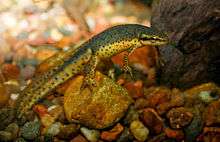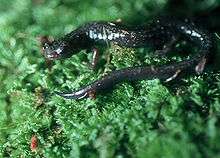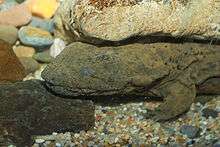List of amphibians of West Virginia






48 species of amphibians (class Amphibia) are known to inhabit the state of West Virginia. The ranges of some 34 salamander species and 14 species of frogs and toads extend into some portion of the state. Two of these — the Cheat Mountain salamander and West Virginia spring salamander — are endemic to West Virginia; they are the only vertebrate species found only within the state. The former species is considered threatened and the latter is considered endangered by federal authorities. Many of West Virginia's amphibian species are declining in population due to habitat destruction and water pollution.[1]
The taxa
The following letters indicate the likelihood of finding each animal in West Virginia:[2]
| C | Common | Can be commonly seen in suitable habitat within current range. |
| U | Uncommon | Seldom seen because habitat restricted and/or behavior secretive. |
| R | Rare | Not often present even in suitable habitat. |
Order Caudata (salamanders)
Family Cryptobranchidae (giant salamanders)
- Eastern hellbender (Cryptobranchus a. alleganiensis) C
Family Proteidae (waterdogs and mudpuppies)
- Common mudpuppy (Necturus m. maculosus) C
Family Ambystomatidae (mole salamanders)
- Jefferson salamander (Ambystoma jeffersonianum) U
- Spotted salamander (Ambystoma maculatum) C
- Marbled salamander (Ambystoma opacum) C
- Small-mouth salamander (Ambystoma texanum) R
- Streamside salamander (Ambystoma barbouri) R
Family Salamandridae (true salamanders)
- Red-spotted newt (Notophthalmus v. viridescens) C
Family Plethodontidae (lungless salamanders)
- Dusky salamander (Desmognathus fuscus) C
- Allegheny Mountain dusky salamander (Desmognathus ochrophaeus) C
- Seal salamander (Desmognathus monticola) C
- Black mountain salamander (Desmognathus welteri) U
- Blackbelly salamander (Desmognathus quadramaculatus) U
- Red-backed salamander (Plethodon cinereus) C
- Ravine salamander (Plethodon richmondi) C
- Northern ravine salamander (Plethodon electromorphus) C
- Valley and ridge salamander (Plethodon hoffmani) C
- Shenandoah Mountain salamander (Plethodon virginia) U
- Cumberland Plateau salamander (Plethodon kentucki) C
- Cheat Mountain salamander (Plethodon nettingi) R
- Northern slimy salamander (Plethodon glutinosus) C
- White-spotted slimy salamander (Plethodon cylindraceus) C
- Wehrle's salamander (Plethodon wehrlei) C
- White-spotted salamander (Plethodon punctatus) U
- Four-toed salamander (Hemidactylium scutatum) C
- Northern spring salamander (Gyrinophilus p. porphyriticus) C
- Kentucky spring salamander (Gyrinophilus porphyriticus duryi) C
- West Virginia spring salamander (Gyrinophilus subterraneus) R
- Midland mud salamander (Pseudotriton montanus diastictus) U
- Northern red salamander (Pseudotriton r. ruber) C
- Green salamander (Aneides aeneus) U
- Southern two-lined salamander (Eurycea cirrigera) C
- Northern two-lined salamander (Eurycea bislineata) C
- Long-tailed salamander (Eurycea l. longicauda) C
- Spotted-tail salamander (Eurycea lucifuga) U
Order Anura (frogs)
Family Scaphiopodidae (American spadefoot toads)
- Eastern spadefoot (Scaphiopus holbrookii) R
Family Bufonidae (true toads)
- Eastern American toad (Anaxyrus a. americanus) C
- Fowler's toad (Anaxyrus fowleri) C
Family Hylidae (tree frogs and allies)
- Eastern cricket frog (Acris c. crepitans) U
- Blanchard's cricket frog (Acris crepitans blanchardi) R
- Gray tree frog (Hyla versicolor) C
- Cope's gray tree frog (Hyla chrysoscelis) C
- Mountain chorus frog (Pseudacris brachyphona) C
- Upland chorus frog (Pseudacris feriarum) U
- Northern spring peeper (Pseudacris c. crucifer) C
Family Ranidae (true frogs)
- American bullfrog (Lithobates catesbeianus) C
- Northern green frog (Lithobates clamitans melanota) C
- Wood frog (Lithobates sylvaticus) C
- Northern leopard frog (Lithobates pipiens) U
- Pickerel frog (Lithobates palustris) C
Threatened species
According to the International Union for Conservation of Nature (IUCN), 7 amphibian species in West Virginia are threatened with extinction.
Eastern hellbender
The eastern hellbender is classified as near threatened. This large salamander lives in rocky, flowing, well-oxygenated streams and rivers in which the water temperature is under 70 °F (20 °C). It shelters under boulders and logs at the river bottom. Its most significant threat is the degradation of its river habitat due to dam and road construction, sedimentation due to logging and mining, and destructive recreational activities. In West Virginia, it is illegal to kill a hellbender or to otherwise remove one from its habitat.[3] Nevertheless, hellbenders are occasionally collected for the pet trade, and some fishermen intentionally kill hellbenders due to the misconception that they are dangerous to humans and sport fish. (In reality, hellbenders are harmless to humans, they eat mostly crayfish, and they usually avoid sport fish.[4]) Conservation efforts include the protection of suitable hellbender habitat, and some zoos participate in the captive breeding of hellbenders.[5]
Streamside salamander
The streamside salamander is classified as near threatened. It lives under rocks, logs, and leaves in hilly areas of deciduous forest with limestone bedrock. It lays its eggs under flat rocks at the bottom of pools and slow-flowing streams, and prefers streams that lack fish. It is mainly threatened by the destruction of its forest and stream habitats to make room for pastures and residential areas. Conservation efforts include the protection of suitable habitat for this salamander.[6]
Shenandoah Mountain salamander
The Shenandoah Mountain salamander is classified as near threatened. This salamander lives under objects in wooded areas. It currently has no major threats, but the species range is small, being less than 8,000 square miles (20,000 km2) in area. More research is needed to determine which conservation efforts (if any) are necessary for this species.[7]
Cheat Mountain salamander
The Cheat Mountain salamander is classified as near threatened. This salamander lives in forests dominated by red spruce (Picea rubens) or yellow birch (Betula alleghaniensis) with plenty of bryophytes and fallen trees, and shelters under rocks and logs. Its main threats include habitat loss due to logging, mining, recreational activities, and road building. Conservation efforts include the establishment of forested corridors to connect isolated populations to each other.[8]
White-spotted salamander
The white-spotted salamander is classified as near threatened. It lives on north-facing slopes in old-growth mixed deciduous forests with Virginia pine (Pinus virginiana), eastern hemlock (Tsuga canadensis), fallen trees, and rocky outcroppings. It shelters under rocks and logs. Its main threats include habitat loss due to deforestation and the introduction of the gypsy moth (Lymantria d. dispar), an invasive species that defoliates many forest trees. Conservation efforts include the protection of suitable habitat.[9]
West Virginia spring salamander
The West Virginia spring salamander is classified as endangered. It is only found in the General Davis Cave system in Greenbrier County, West Virginia. This salamander lives in and along limestone streams with plenty of decaying organic matter. It currently has no major threats, but logging and pond construction outside and above its cave habitat could threaten its existence. Sections of the cave are currently owned and protected by The Nature Conservancy.[10]
Green salamander
The green salamander is classified as near threatened. This salamander lives in damp crevices in rock outcrops with plenty of shade. It can also be found under loose bark or in the cracks of trees. Its main threats include habitat destruction due to land development projects. Conservation efforts include the protection of suitable habitat, especially forested areas around rocky outcrops.[11]
See also
- Lists of amphibians by region
- West Virginia State Wildlife Center, a small zoo featuring native West Virginia animals
- Fauna of West Virginia
- List of West Virginia wildlife management areas
References
- ↑ http://www.wvdnr.gov/Wildlife/RepAmph.shtm
- ↑ http://www.wvdnr.gov/Publications/PDFFiles/amphibian%20checklist2.pdf
- ↑ http://www.wvcommerce.org/App_Media/assets/publications/naturalresources/ReptilesAndAmphibiansRegulations.pdf
- ↑ Herman, J. 2000. "Cryptobranchus alleganiensis" (On-line), Animal Diversity Web. Accessed August 13, 2015 at http://animaldiversity.org/accounts/Cryptobranchus_alleganiensis/
- ↑ Geoffrey Hammerson, Christopher Phillips 2004. Cryptobranchus alleganiensis. The IUCN Red List of Threatened Species. Version 2015.2. <www.iucnredlist.org>. Downloaded on 12 August 2015.
- ↑ Geoffrey Hammerson 2004. Ambystoma barbouri. The IUCN Red List of Threatened Species. Version 2015.2. <www.iucnredlist.org>. Downloaded on 12 August 2015.
- ↑ Geoffrey Hammerson 2004. Plethodon virginia. The IUCN Red List of Threatened Species. Version 2015.2. <www.iucnredlist.org>. Downloaded on 12 August 2015.
- ↑ Geoffrey Hammerson 2004. Plethodon nettingi. The IUCN Red List of Threatened Species. Version 2015.2. <www.iucnredlist.org>. Downloaded on 12 August 2015.
- ↑ Geoffrey Hammerson, Joseph Mitchell 2004. Plethodon punctatus. The IUCN Red List of Threatened Species. Version 2015.2. <www.iucnredlist.org>. Downloaded on 12 August 2015.
- ↑ Geoffrey Hammerson, Christopher Beachy 2004. Gyrinophilus subterraneus. The IUCN Red List of Threatened Species. Version 2015.2. <www.iucnredlist.org>. Downloaded on 12 August 2015.
- ↑ Geoffrey Hammerson 2004. Aneides aeneus. The IUCN Red List of Threatened Species. Version 2015.2. <www.iucnredlist.org>. Downloaded on 12 August 2015.

